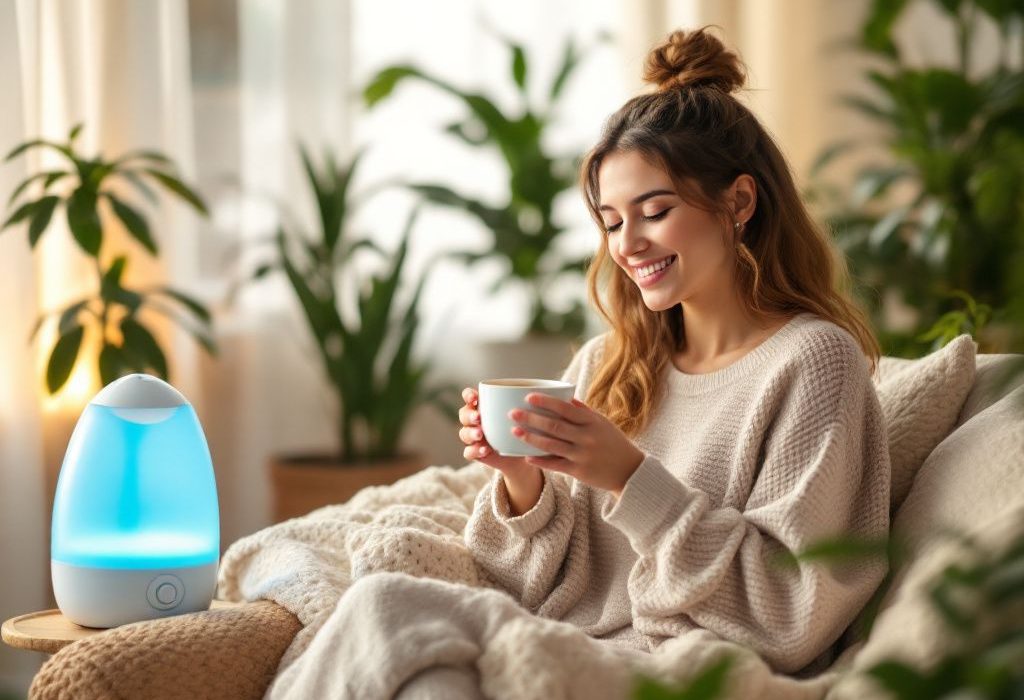We’ve all felt it: the hum of a heater kicking in on a cold winter’s night, the satisfying wave of warmth that eases tension in our bodies. But have you ever stopped to think about how artificial heat impacts your skin? Yep, that’s right. Our quest for comfort might just be tipping the scales, messing with our skin’s natural balance in some intriguing, and not always kind, ways. Understanding how this balance is affected can be crucial, especially when considering the unique changes pregnancy brings to skin. Moreover, the interplay between environmental factors and skin conditions is a field of growing interest, with many turning to beginner-friendly skincare innovations to mitigate these effects.
The Cozy Paradox: Comfort vs. Skin Health
Fireplaces, central heating systems, space heaters—these modern conveniences give us that snuggly, warm feeling when there’s a chill in the air. But all this artificial heat, while fantastic for making us feel toasty, might be less of a friend to our skin. Not to be the bearer of bad news, but dry, itchy skin often comes along for the ride. It’s like the uninvited plus-one to every warm gathering. Humidifiers can help—you know, those little gadgets that pump moisture back into the air? They’re like a blessing wrapped in plastic. Give one a try, especially in those places you spend a lot of time in. Your skin will thank you, particularly when you build a pregnancy-safe skincare routine that considers these factors.
Met Your Match: The Dryness Battle
Let’s face it; our homes can sometimes feel like mini-deserts during chilly months. Artificial heat cranks up dryness by drawing moisture from the air, which in turn zaps it right from our skin. Without sufficient ambient moisture, our skin starts to resemble sandpaper more than the smooth surface we’d all prefer. Trust me on this one, investing in a quality moisturizer isn’t just a splurge; it’s essential. Look for products rich in hyaluronic acid benefits for skin or glycerin—they work wonders in locking that much-needed moisture in.
The Subtle Art of Indoor Aging
No pressure here, but these dry, heated environments might accelerate what’s known as indoor aging. Stay with me. While we’re familiar with sun-induced aging, indoor aging is sneakier. It occurs because artificial heat dries out collagen over time, reducing our skin’s elasticity. It’s like when that comfy old couch you love loses its mojo—it looks a tad droopy and worn. Regular application of collagen-boosting serums can take the edge off. You might want to add those to your daily mix if they’re not already starring in your morning ritual. Moreover, understanding the science behind skin hydration can further aid in combating these effects and rejuvenating your skin’s natural glow.

Quick Tips for Staying Ahead
- Hydrate, Hydrate, Hydrate: Your skin craves water. Drink it, obviously. But also look for serums and treatments that ramp up hydration levels and consider the best night moisturizers to lock in moisture while you sleep.
- Moisturize Like You Mean It: Apply thick, nourishing creams right after a shower. Your skin is primed to absorb moisture when slightly damp.
- Deploy a Humidifier: Not just for the living room. Consider them for bedrooms and offices too. Think of it as spreading cheer to your skin.
- SPF Is Still a Thing: Even indoors, UV rays sneak in through windows, and heated lights can contribute their part. Don’t see your sunscreen as a thing to skip.
Sacrificing Skin Elasticity and Firmness: The Long-Term Play
Another harsh truth—constant exposure to artificial heat minimizes collagen and elastin, which are crucial for keeping skin firm and bouncy. Collagen isn’t just for celebrity endorsement; it’s healthily legit. Protect your skin’s elasticity with vitamin C and antioxidants, known to be major players in reversing these harsh effects. As you explore natural options, consider natural products that are good for your skin for a holistic approach. These natural remedies are gaining traction for their effectiveness and minimal side effects, offering a gentle yet potent alternative to conventional products.
Feel free to throw some into your diet too—orange juice for mornings, berries over cereal. It’s the little things.
How to Navigate Indoor Headaches (A Quick Table):

| Problem | Solution |
|---|---|
| Dry Skin | Humidifier + Moisture-rich Creams |
| Accelerated Aging | Collagen & Antioxidant Serums |
| Loss of Glow | Hydrate + Exfoliate Gently |
| Dull, Lackluster Pores | Regular Cleansing Regimen |
These steps aren’t huge shifts but rather slight, manageable marches in your everyday routine. Now, let’s move on to embracing more homemade skincare solutions that work wonders without harsh chemicals. These solutions not only nourish your skin but also align with sustainable practices, offering a win-win for both beauty and the environment.
Sustaining a Balanced Refuge: A Deeper Dive
Wouldn’t it be great if there was an indoor sanctuary that protected your skin too? Think of your home as a refuge from outdoor elements, but you still want to maintain balance inside. Fresh air, opening the windows from time to time (even in winter), welcomes a more natural climate and resets those dry, artificial heat vibes. Even a quick vent will help amalgamate dry air with something that doesn’t scream “dehydrated.” Balance is key, not just for yoga but in everything, and the concept of beginner-friendly skincare innovations can assist in achieving this harmony.
Throw in some plants as well; they’re nature’s humidifiers. Not sure where to start? Peace Lilies, Snake Plants, even humble Spider Plants double up as oxygen-givers and vibe-enhancers.
On the Essentiality of Natural Light
You know what works fabulously with your newly refreshed ambiance? Natural light. Pull back those curtains when you can. It’s not just for mood-boosting or photosynthesis enthusiasts—sunlight is part of the good skin package. Complement this with ultimate cream skincare routines for optimal results. These routines help maximize the restorative power of sunlight, ensuring your skin remains vibrant and youthful.
Temptation of Instant Comfort: Rescue Remedies
We all wander into using blazing hot showers and heaters cranked to max for instant comfort. Remember? Balance is essential. Consider dialing it down. Gentle warmth versus volcano-level heat. Your skin will adjust accordingly, developing resilience while you remain comfortable. Gradual transitions are often the way to go, just like when switching products in a skincare routine. For evening routines, consider the best natural night creams to aid recovery while you rest.

Let’s get practical with steps:
- Temperature Moderate: Keep room temperatures at moderate levels—shooting for the arctic or Sahara isn’t sustainable.
- Cool Water Cleanses: Wash your face with lukewarm (not hot) water; it’s kinder to your skin barrier.
- Post-Heat Skin Treatments: Explore calming face masks or after-sun products; they replenish called-upon reserves.
Final Thoughts: Lending the Ear of Experience
Folks, don’t agonize. Our modern lives offer shortcuts and lapses. It’s natural to crave heat in cold times. But this discourse isn’t about guilt—it’s recognizing tiny changes prioritizing skin health. Artificial heat? Delve less into challenges and focus on creative solutions for balanced skin vitality.
And there it is. By now, those curiosity vectors planted early on should be anchoring in pleasant realizations. Artificial heat plays its villain card, but savvy skin stars know holding the tricky smoke mirror up ends not only with looking presentable but feeling soothed and re-hydrated.
By ensuring your skin stays moisturized, hydrated, balanced, and pampered, you’re winning the race against artificial heat. So, cozy up knowing your skin’s in the safe zone. Consider these efforts your personal sanctuary portrait on self-preservation.
Frequently Asked Questions
What are artificial sources of heat?
Artificial sources of heat include devices such as electric heaters, gas furnaces, wood stoves, oil heaters, and even electric blankets. These devices generate heat through various mechanisms like resistance heating, combustion, and burning wood to warm indoor spaces[1].
How do artificial heat sources affect indoor air quality and health?
Artificial heating can dry the air, irritating the nasal passage and lungs, leading to issues such as dryness, cough, and dehydration. Continuous use of heaters can also decrease oxygen levels, increase carbon dioxide, and cause respiratory problems. Additionally, it can lead to skin irritation, itching, and rashes[2].
What are the advantages of using heat pumps as an artificial heat source?
Heat pumps are more energy-efficient than traditional heating methods as they transfer heat rather than generate it. They can move heat from a colder place to a warmer place, making them effective for both heating and cooling. Heat pumps are also environmentally friendly and can provide full central heating with high efficiency[4].
How should artificial heat sources be used safely and responsibly?
It is important to use artificial heat sources safely by ensuring proper ventilation to maintain oxygen levels and reduce the buildup of carbon dioxide. Regular maintenance of the devices, keeping them away from flammable materials, and following the manufacturer’s instructions can help prevent accidents and health issues[1][2].
References


